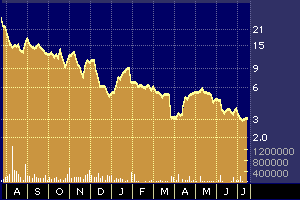
Wink Stock Outruns Company Performance
Wink Stock Outruns Company Performance
by Hal Plotkin
Silicon Valley Correspondent
Wink Communications Inc.’s {WINK} stock price has soared since the company’s recent initial public offering, though the money-losing Interactive TV company shows no signs of posting profits anytime soon.
“A lot of people are making very aggressive forecasts for the market [Wink’s] in,” says James Penhune, an analyst at the Yankee Group based in Boston. “But I wouldn’t be surprised if, at least over the next few years, the real numbers turn out to be considerably lower.”
Wink went public Aug. 19 at $16 a share, ending the day with a gain of 123 percent. More recently, the company’s shares have been changing hands at as high as $55.25.

Wink Communications Inc. {WINK} |
 |
Detailed Quote |
 |
Financial Statement | |
 |
Recent Events | |
 |
Company Snapshot | |
 |
Quarterly Earnings | |
 |
Key Statistics | |
 |
IPO Market Is Back From Summer Break |
Alameda, Calif.-based Wink produces software for TV set-top boxes that enable consumers to use their TV remote controls to make purchases or request information. To use the service, viewers must be watching Wink-enabled programming.
The company has been losing money ever since it was established in 1994. Wink lost $2.1 million in 1995, $5.8 million in 1996, $9.1 million in 1997, and another $14 million last year. Annual revenue, on the other hand, has never surpassed $620,000.
So, what accounts for the stock’s recent dramatic climb?
For starters, the company is benefiting from rising hopes for a rapid roll-out of broadband cable-TV access and projecting strong sales of the companion digital, Internet-enabled TV set-top boxes.
While some Wink features work on older, analog cable-TV systems, the technology is expected to gain its largest audience after the next generation of high-performance digital TV set-top boxes move off factory floors and into people’s homes.
More than 25 million homes are expected to have access to enhanced broadcast services by 2004, according to a recent forecast by Cambridge, Mass.-based Forrester Research.
“We’re pretty bullish on the prospects for this part of the market,” says Forrester Research’s principal analyst of new media research Josh Bernoff. “We think Wink is well-positioned to take advantage of the growing market.”
Bernoff says he likes Wink’s business plan, which calls for the company to act as an intermediary between cable TV operators and consumers, generating a commission each time a consumer places an order with their TV remote control.
“You might call this a kind of lazy interactivity,” Bernoff says. “It’s for people with short attention spans, people with a remote control in one hand and a beer in the other.”
If consumers watching a TV commercial for pizza, for example, see Wink’s little “i” icon on their screen, it means the commercial is Wink-enabled. By pushing a few buttons on their remote control, they could order a pizza and have it delivered to their home without ever leaving the couch.
Wink’s image has been burnished in recent months by a slew of announcements from major broadcasters, including NBC, CBS, and ABC, as well as cable broadcasters such as AT&T-owned TCI and Time Warner Cable.
Those firms, and others, have all signed agreements to either license Wink’s technology or test-market it in selected areas. Market tests are under way in California, Connecticut, Illinois, Missouri, and Tennessee. All told, about 40,000 U.S. households are participating in the tests.
The company has also benefited from some high-profile backing. Last June, Redmond, Wash.-based Microsoft Corp. {MSFT} paid $30 million for a 10 percent stake in the company.
That investment followed an earlier $10 million investment from Vulcan Ventures Inc., the investment firm owned by Microsoft cofounder Paul G. Allen.
Even so, some analysts say the rapid rise in Wink’s stock price may soon leave some Wink investors feeling like poster children for Irrational Exuberance Anonymous.
The problem, they say, is that Wink won’t have a real opportunity to prosper until after the expected build-out of next-generation digital TV and the set-top boxes that go with it, takes place.
“For Wink to really take off, you have to assume four things,” Penhune says. “First, you have to assume the rapid upgrading of the [cable and satellite TV] network infrastructure takes place, that it’s digital and broadband, that it’s two-way, and that it’s widely adopted by consumers. All that has to happen before Wink can build substantial sales.”
Penhune adds that all those ingredients will eventually fall into place but probably not as quickly as at least some of those who have bought Wink’s stock seem to expect.
Cynthia Brumfield, an analyst at Broadband Intelligence, based in Bethesda, Md., agrees, up to a point. “It’s not something that is going to happen overnight,” she says. “But what the company does have going for it is all those alliances. We’re just at the beginning stages of the broadband era, and Wink is working with the right partners.”
Penhune, on the other hand, says anything could happen between now and whenever there are enough installed digital TV set-top boxes to give Wink a shot at success.
“The big broadcasters are very unsure of what is going to happen so they are spreading their bets around the table,” Penhune adds. “And Paul Allen has invested in everything. I’m not too impressed by either of those facts. It’s going to come down to getting advanced set-top boxes into enough homes, getting the Wink technology into those boxes, and getting programmers to use the technology. There’s still a substantial challenge there.”
For the six months ended June 30, Wink posted a loss of $9.2 million on revenue of $620,000. That compares with a loss of $5.7 million on $290,000 in revenue for the first half of 1998.


